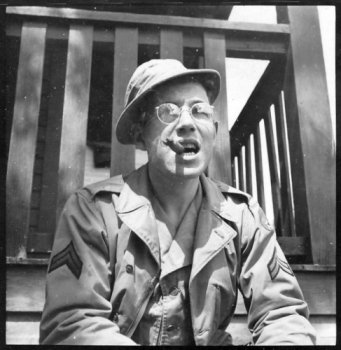Louis J. Gendler was twenty-one years old and single when he enlisted on 22 Apr 1942, at Springfield, Massachusetts. Records show he was from Franklin County, MA, but we do not yet know which town. Nor do we know of Gendler's activities for the next 12-14 months.
Sometime in early 1943, Louis volunteered to be a Combat Cameraman and was sent to the First Motion Picture Unit. He completed Combat Photographer training at F.M.P.U. ,was assigned to the cadre of the 16th Combat Camera Unit, and departed "Fort Roach" for overseas on 30 July 43. After a long trip aboard ship, he reached India, and then faced several days of traveling on several different trains and a river steamer to reach Chabua, India. A relatively short, but exciting plane ride took Louis and the rest of the cadre to Kunming, China, on 25 October 1943.
Initially he assisted with getting the Unit settled in; equipment unpacked and readied for use, supplies acquired and stored. He was promoted to Sergeant on 15 Nov 43.
On 7 Dec 1943, Corporals Louis Gendler and Blaine Campbell were sent to Yunnanyi, China on temporary duty assignment, the first assignment for each. They joined Sergeant ? Gough, already there, and assisted in completing the assignment to photograph ground and air activities of the squadrons station at the airbase. They alternated, so that none was flying two days in a row.
An entry in the May 1944 History Summary of the 16th CCU reads, "Sergeant Gendler left Kunming on a sea sweep with the 425th Bombardment Squadron. The plane on which he was flying crashed into the South China Sea just south of Hong Kong. The whole crew is believed to have been killed. Sgt. Lewis J. Gendler will always be remembered by his officers and buddies as a man who was courageous and a sincere worker. His absence will be deeply felt in the unit. His jovial spirit will live forever"
Early morning of 20 May 1944, this B-24 from Liuchow Airbase was flying a sweep over the South China Sea when it spotted a convoy of ten ships and reported the convoy's position via a radio message back to base. Such an opportunity could not be passed up, and command ordered multi-plane attacks.
Several B-24s were temporarily at Liuchow, in preparation for a forthcoming heavy bomber attack mission. After a hasty briefing, thirteen Liberators, representing all four squadrons of the 308th Group, took off and departed individually. They each flew out over the South China Sea in search of the convoy. Eleven of the planes reached the area, spotted shipping and performed attacks.
Unfortunately, at least two destroyers were accompanying the freighters, and all ships put up fierce anti-aircraft fire as each bomber attacked. One B-25 burst into flame and crashed into the sea just after completing its attack on a destroyer, which was left ablaze. Another bomber, attacking the same convoy, was also hit and was smoking as it left the convoy; crashing very soon after. A third Liberator, while attacking a possible second convoy, exploded and burst into flame during its attack.
Missing Air Crew Report for men aboard 425th Squadron's plane 42-100249 was filed, and later designated MACR 5153. These crew members remain missing -
1Lt. Donald Campbell, Jr.; pilot
1Lt. James L. Harper; copilot
2Lt. Basil Barna; bombardier
2Lt. Lloyd F. Kent; navigator
TSgt. Luther F. Romine, Jr.; engineer
TSgt. Georger McCorkell; radio operator
Cpl. James C. Kent; assistant engineer
SSgt Robert J. Cromer; assistant radio operator
SSgt Gerard R. Eberhart; gunner
SSgt Garland B. Jeffries; gunner
Sgt. Louis B. Gendler; combat photographer, 16th CCU

